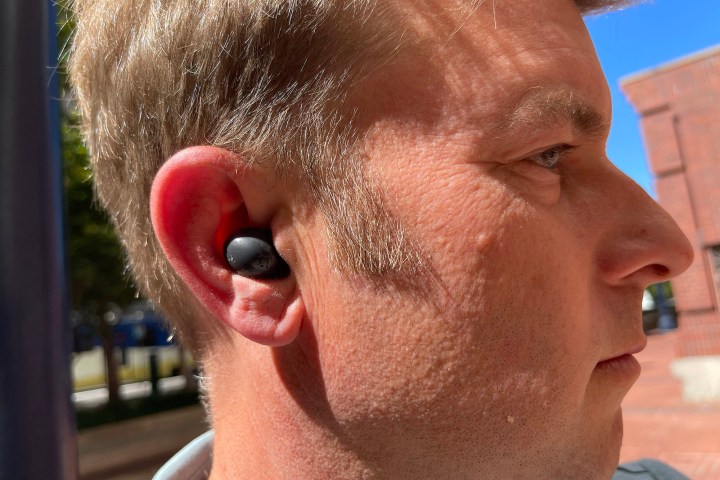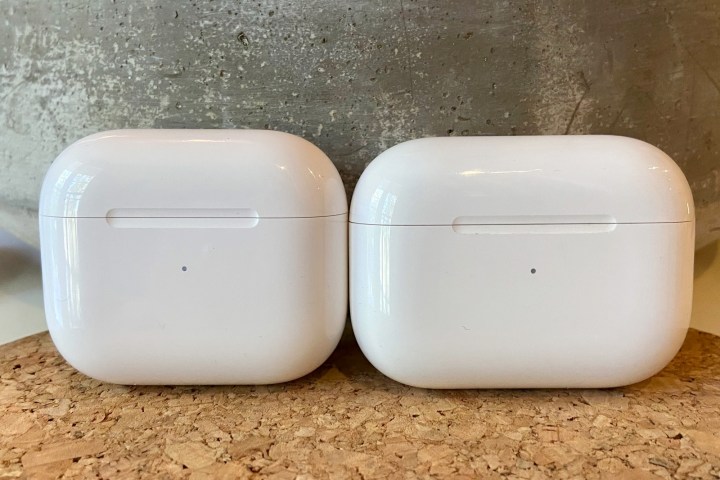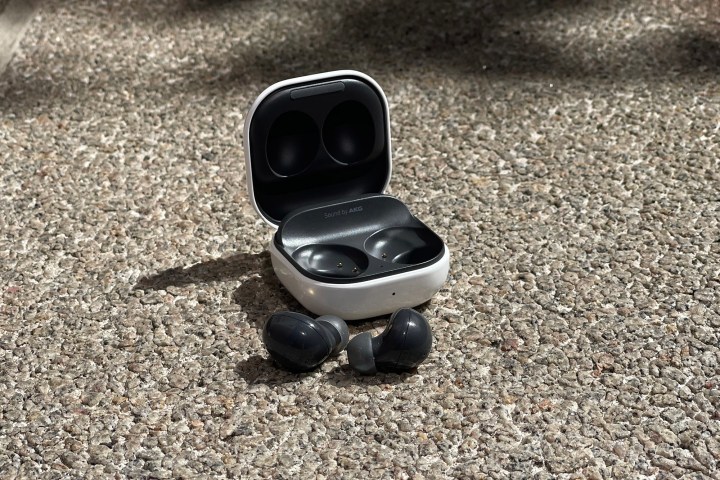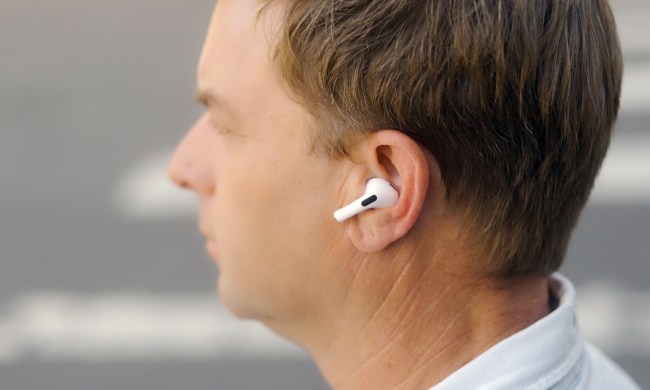If you’re in the market for a set of top-notch earbuds, one thing you’ll notice right away is just how many pairs there are to choose from. With name brands a-plenty, it’s tough to decide where to even start, but take it from us — you can’t beat premium. When it comes to industry-lauded, flagship performance, nothing says “premium” like a pair of buds from Apple or Samsung. Both brands have a gleaming track record of producing some of the leading in-ear audio products, offering features like powerful noise cancellation, customizable haptics, and dirt/water protection for the toughest commutes.
Thus, the question remains: Do you invest in Apple’s AirPods 3 or Samsung’s Galaxy Buds 2? Let’s put both buds side by side to help you decide which set is best for you.
For those looking for more wireless earbud options, check out our roundup of the best true wireless earbuds you can buy right now.
Design
Apple’s original AirPods and AirPods 2 buds were never quite hailed for comfort. More specifically, a lack of silicone eartips made for a slightly loose-fitting feel for some ears, and no official IP resistance kept certain buyers at bay. With the third generation of AirPods, or AirPods 3 as they’re being referred to, Apple upped the ante in several of these categories. For one, the new bud design goes for a more bulbous and smooth shape. This, combined with the shorter tail-fins, helps the AirPods hug the skin of the outer ear. There’s also an official IPX4 designation, which checks that box now. Overall, the AirPods 3 look sleeker, fit nicely, and are better protected than the AirPods 2 — although the AirPods Pro still offer a tighter ear-grab for workouts.
Samsung, on the other hand, offers a smaller, more ergonomic in-ear design with its Galaxy Buds 2. The headphones come with small, medium, and large eartips, fit snugly inside your ears, and even come with silicone earfins to ensure they don’t fall out during strenuous exercise. In our full hands-on review, the Galaxy Buds 2 stayed put for long periods of time without any kind of discomfort or sweating, even staying secure during a long snooze.
While Apple certainly made some strides in improving the design and comfort of the AirPods 3 over older generations, the Galaxy Buds 2 are better looking, more comfortable, and snug in all the right ways.
Winner: Galaxy Buds 2
Control options
Both Apple and Samsung wireless buds use fairly seamless tap-based controls for a number of functions, including play/pause, call answering, and digital assistants.
In Apple’s case, the AirPods 3 have done away with tapping control gestures, relegating commands to the force sensors located on each bud stem — an improvement borrowed from the AirPods Pro. Touch commands are as follows: A single sensor-tap for play/pause, a double-tap to skip forward, and a triple-tap to skip back. To adjust volume and to initiate assistant commands (like calling a certain iPhone contact), say “Hey Siri,” followed by the command you’d like carried out. If you use touch commands often, though, you may find yourself dislodging whatever seal the AirPods 3 have with your ears. As stated, they fit better than older gens, but not as tightly as the AirPods Pro. Silicone eartips could have been the cure-all.
Out of the box, the Galaxy Buds 2 offer a bit more in terms of control, but a stemless design means you’ll be tapping the outside of the buds that are in your ears. Normally, this wouldn’t be such a big deal, but when it comes to sensitivity, the Buds 2 are a bit too sensitive. Even the lightest of touches when trying to adjust will set off an unintended play/pause command or ANC (active noise canceling) change. Luckily, you can turn off the touch sensor with the Galaxy Wear app, but you’ll lose those touch features altogether, and you’ll need to launch the app to turn them back on.
Getting into the actual tap commands, single, double, and triple taps all perform different functions, including play/pause, call answering, and voice assistant cueing. A hidden gem for Samsung is the inclusion of an assignable “fourth” command (only available with Android devices). Instead of sequential taps, users can long tap to access either voice commands, quick ambient sound (which reduces music volume so you can hear outside sounds), as well as volume down.
Overall, we found Samsung’s controls a bit easier to use and customize, and the additional fourth command was just enough to edge the Galaxy Buds 2 over the less option-filled AirPods 3 in the control category.
Winner: Galaxy Buds 2
Listening experience
Apple’s AirPods will let you listen to your favorite music for up to six hours between charges, which is still fairly good in the world of true wireless headphones. Plus, with a fully charged AirPods case, you’ll get up to 30 hours total. In addition to quick pairing and low video latency, Apple has redesigned its latest buds to support spatial audio listening. This is a great add-on that uses head-tracking technology to adapt your listening experience to whatever direction you’re facing, making you feel like you’re smack-dab in the middle of a recording session with your favorite artist. For Apple Music subscribers, this is a fantastic way to experience the myriad of Dolby Atmos tracks in Apple’s music library.
In terms of overall sound quality, the AirPods 3 offer warm and rich bass and shimmering clarity in the higher frequency ranges. While the semi-open design allows a little too much sound in from time to time, the AirPods 3 are easily the best-sounding generation, outside of the flagship AirPods Pro. The passive cancellation of the AirPods 3 does get the job done, but we would have loved to see the active noise cancellation of the Pro series carried over.
The Galaxy Buds 2 slightly outperform the AirPods in virtually every way when it comes to the listening experience. First, and perhaps most significantly, the Galaxy Buds 2 come with active noise cancellation. And while they’re not quite at the same level of ANC as the AirPods Pro, for $50 cheaper than the non-ANC AirPods 3, you can’t go wrong. And to be clear, Digital Trends reviewer Caleb Denison said the Buds 2 had “the best noise-canceling buds I’ve heard from Samsung yet,” so combining that with punchy low-end, a boost in upper treble for shining vocals, and decent midrange that brings everything home, the Galaxy Buds 2 may not quite reach premium performance, but considering Samsung’s mass-market appeal, they’re not far away. Plus, with the expanded EQ app (for Android devices only), you can dial in your audio just the way you like it.

Another thing to consider when it comes to listening experience is just how life-proof headphones are. In this case, the Buds 2 slightly nudge out the AirPods 3 with an IPX7 rating, which means they can withstand workout sweat and dripping water (though they’re not fit for the pool).
Winner: Galaxy Buds 2
Charging case and battery life

As mentioned, Apple’s AirPods 3 will last up to 6 hours on a full charge, with up to 30 hours total if you’re traveling around with a fully juiced charging case. As part of Apple’s conversion to MagSafe charging, the latest AirPods incorporate MagSafe magnets for the case, allowing you to dock the cased AirPods to any MagSafe charger, flat or upright. Apple’s fast-charge feature will also net you an extra hour of playtime after charging the buds for only five minutes.
The Galaxy Buds 2 case doesn’t offer the same kind of longevity, but the pillbox-style case does come with wireless charging at no extra cost. With ANC enabled, users can expect up to 5 hours of playtime and 3.5 hours of talk time. With the charging case, and with ANC enabled, you can expect 20 hours of playtime and 13 hours of talk time total. With ANC disabled, you’re looking at up to 7.5 hours of playtime and 3.5 hours talk time — 29 and 14 hours with the case, respectively.
Additionally, you should be able to get about one extra hour of playtime off a quick five-minute charge and about 2.5 extra hours off a 10-minute charge, getting the charging and overall battery performance of the Galaxy Buds 2 right in line with the AirPods 3.
Winner: Tie
Call quality
The AirPods 3 and Galaxy Buds 2 are more than adequate when it comes to call quality, both for the bud-wearer and the person they’re talking to. For the AirPods 3, Apple incorporated a new AAC-ELD codec to improve voice clarity over FaceTime calls. This, combined with acoustic meshing to cut down on wind noise and other environmental distractions, as well as Apple’s tried-and-true mics, makes the AirPods 3 an easy choice for frequent callers.
On paper, it would seem that the Galaxy Buds 2 should deliver better call quality than the AirPods, due mostly in part to Samsung’s triple mic system that adapts each bud to the noise environment. But generally speaking, we found that while phone calls came in adequately on the Galaxy Buds 2, our call recipients claimed we sounded a bit tinny and digitized. The default call-EQ was also a little boomier than the AirPods. Thus, we award the AirPods 3.
Winner: AirPods 3
Pricing
The AirPods 3 currency sells for $180. For those who opt to purchase AppleCare+, the replacement fee for damaged AirPods and the wireless charging case are only $29.
The Galaxy Buds 2 can be purchased for $150. The one caveat is that for lost or damaged buds or chargers, you’ll need to reach out to Samsung Support for any replacements. A number of third-party Galaxy Buds charging cases are also available online, but we recommend contacting Samsung instead of purchasing an off-brand charge case.
While it’s always nice to have options, we’re giving this category to the Galaxy Buds for having the overall best price. And in cases where something goes wrong, you can still reach out to Samsung for additional support.
Winner: Galaxy Buds 2
Verdict
While there is a lot to like about both pairs of these true wireless earbuds, there is no question that the Samsung Galaxy Buds 2, which retail for $150 compared to $180 for the AirPods, are the better value.
With an awesome listening experience, better fit, and better control, the Galaxy Buds 2 beat out Apple’s third-generation true wireless AirPods, making them our winner in this head-to-head contest.
Want a little more insight? Check out our full reviews of the Samsung Galaxy Buds 2 and the Apple AirPods 3.





